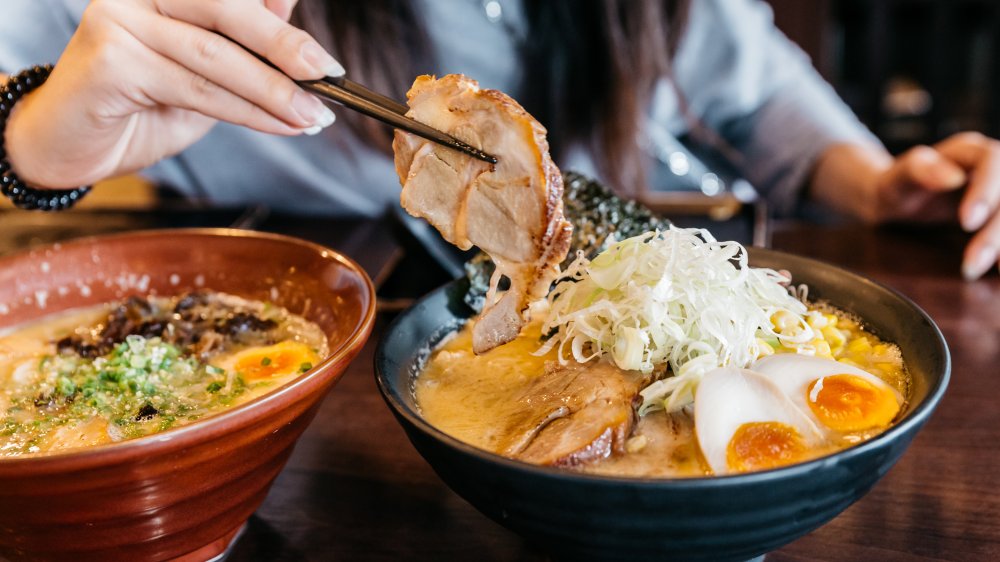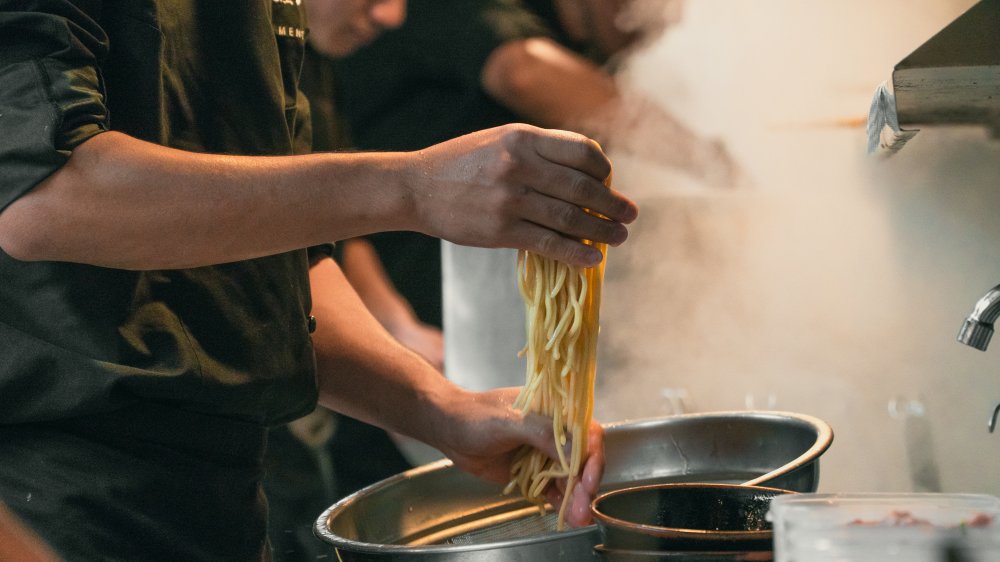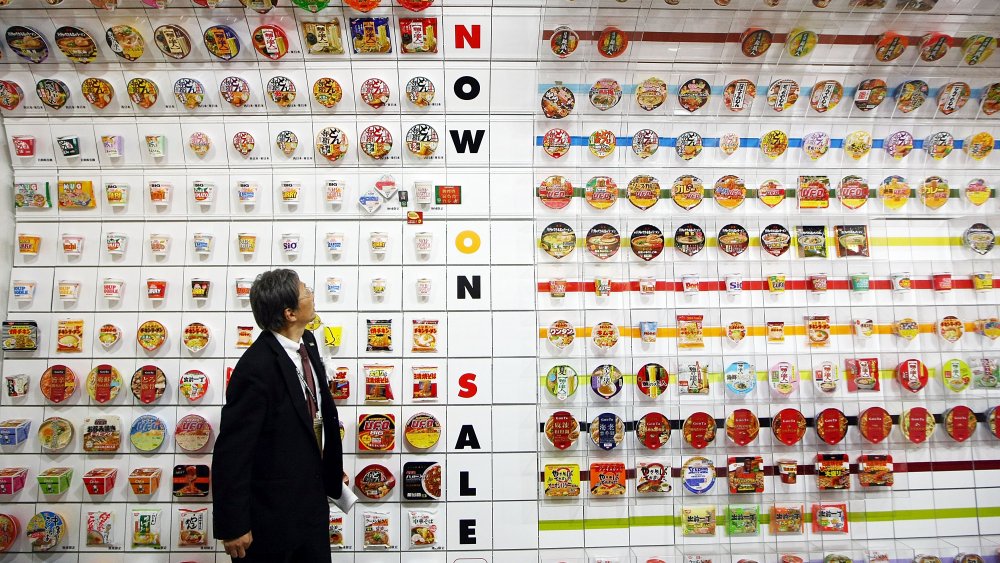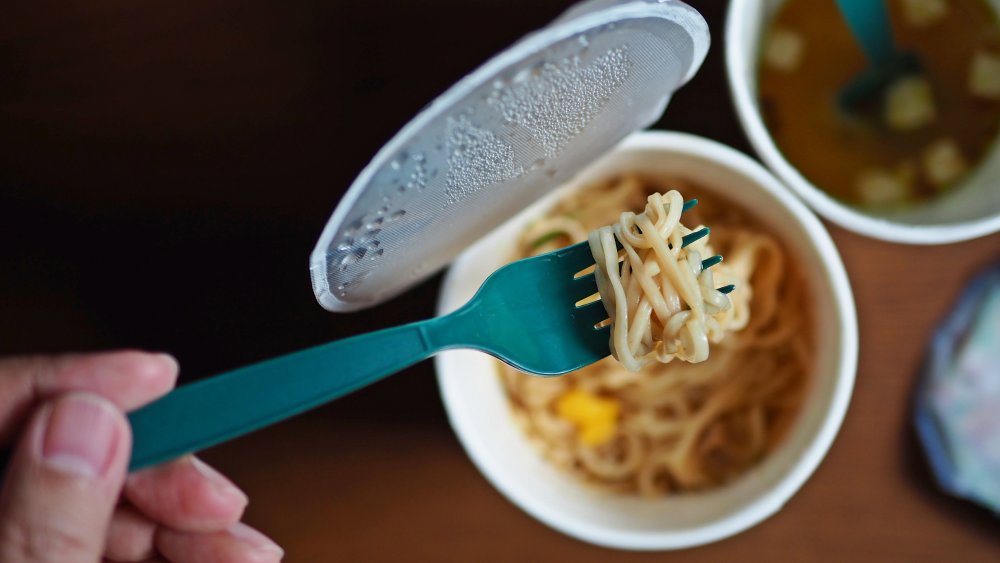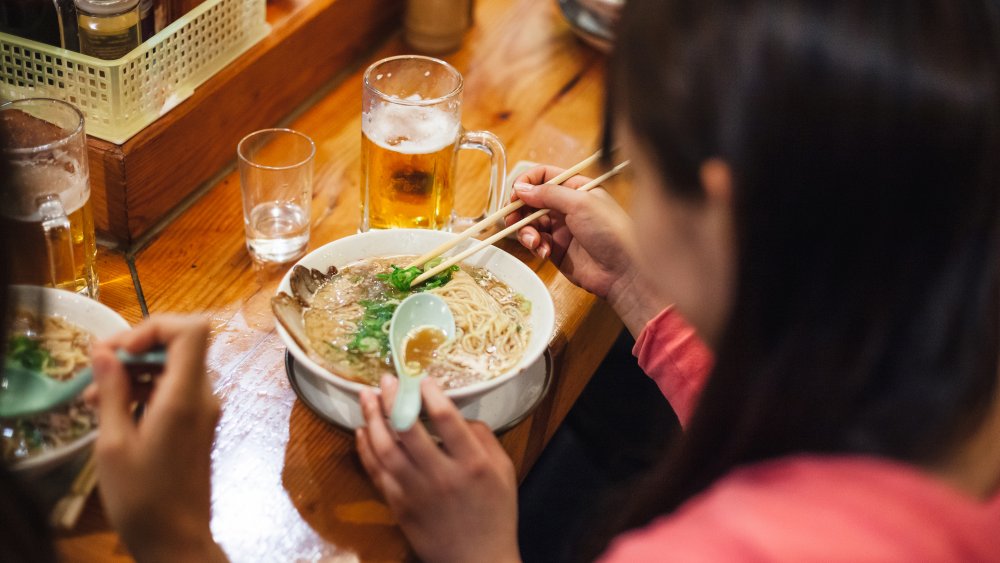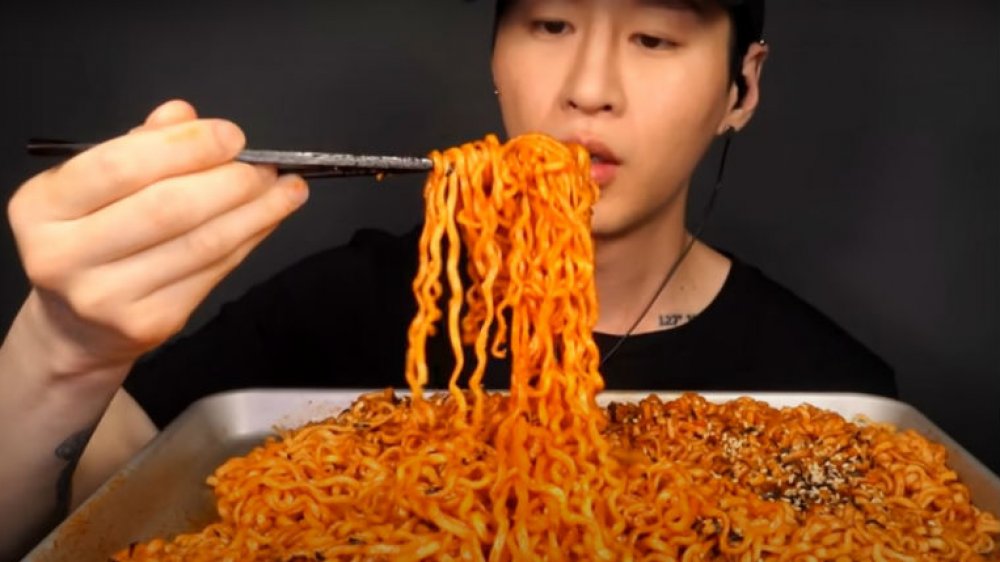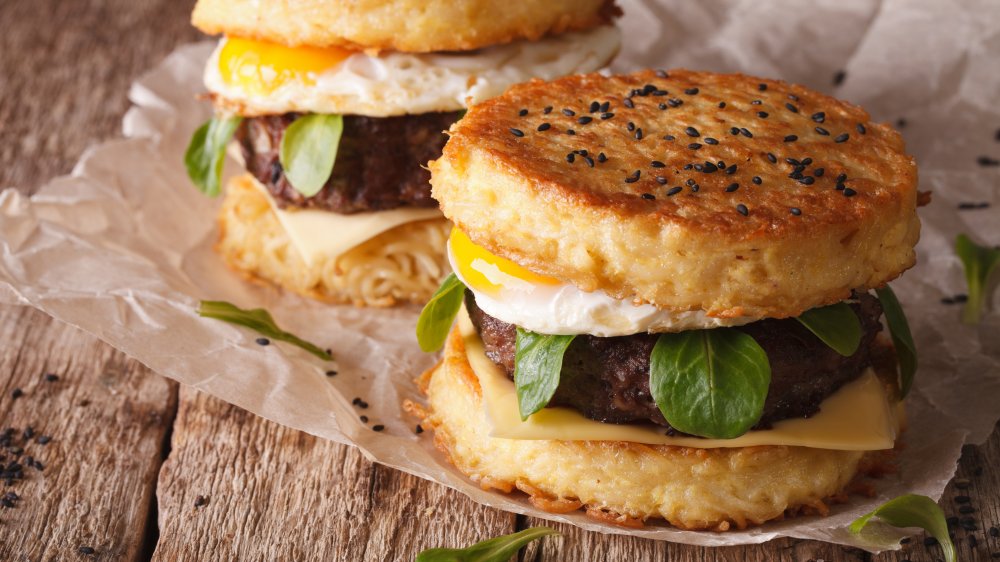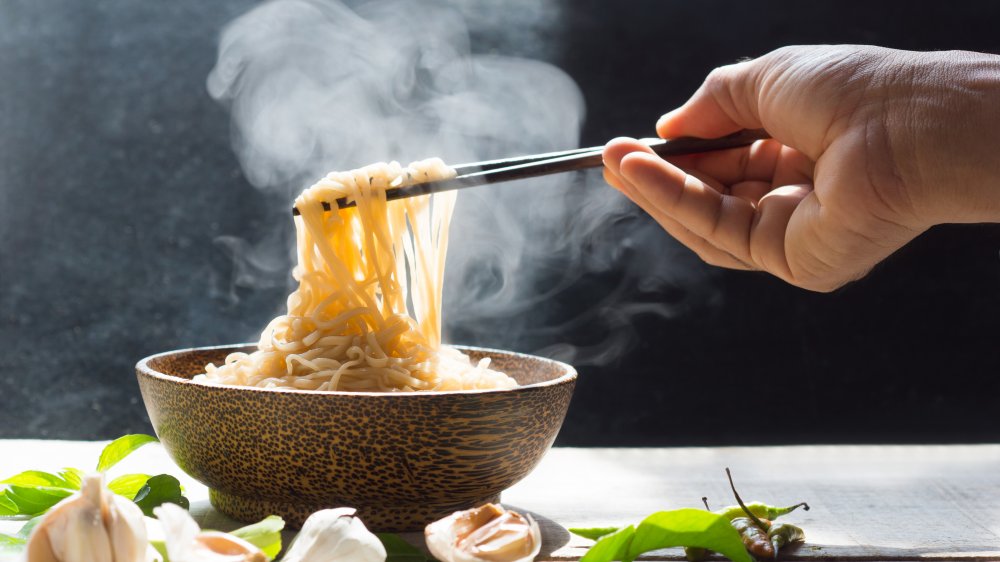Everything You Need To Know About Ramen
We may receive a commission on purchases made from links.
There are so many different noodle dishes in the world your head starts spinning when you try to think of them all. So many shapes, so many textures, but so little time to eat them all! Noodles one of those versatile foods you can pair with pretty much anything. In America, when we hear the word "noodle" we immediately think of pasta, of course. However, a heaping pile of starchy strands doesn't always come with a ladle full of marinara sauce or a hearty mound of bolognese. If you enter into the vibrant — and equally delicious — noodle world in Japan, you find yourself rethinking how America does noodles. And, one of the best meals to kick off this brand-spankin' new way of thinking is Ramen.
You might think of Ramen as those obnoxiously cheap packets of dry noodles with flimsy seasoning packets, and for good reason. That's exactly what's thrown in our faces at supermarkets everywhere. But, those rock hard squares of noodles you pop into boiling water are the exact opposite of the real thing. Authentic ramen — the kind made with a rich broth and served with a medley of seasoned veggies and tender meat — puts the supermarket stuff to utter shame.
Regardless of what you know about this epic noodle dish, strap in for one heck of a tasty ride. Here's everything you need to know about this Asian treat.
It's polite to slurp ramen loudly
Who would ever want to accept a seat at a restaurant that had rows of guests around them slurping their meals loud enough to register on the Richter scale? That environment would warrant a swift, "No thanks, actually. We'll go somewhere else." The sound of munching down a meal immediately turns plenty of people off. It's hard to enjoy food when only four feet away is a noise that conjures up an image of a sloppy mouth-mashing. Gross. But, if you find yourself in a ramen joint, brace yourself for a slurpathon rivaled by no other type of restaurant in the world.
Those who aren't accustomed to the delightful world of ramen would easily see the slurping as rude. However, there's actually a very good reason for the seemingly annoying action. Since ramen is served steaming hot, immediately thrusting a mouthful of broth-soaked noodles into your mouth is a bad idea. What the slurping does, however, is allows the noodles to not only cool off but aerate, as well, and this helps immensely to release all the subtle flavors hidden deep within the spiced broth. Pretty genius stuff going on here. So, the next time you're served a bowl of ramen, put your table manners aside for a bit and slurp that dish loud and proud.
Ramen didn't originate in Japan
Many foodies don't just love exploring new and unique dishes for the flavor. Sure, diving into something new is always exciting, but the history behind a dish is equally as fascinating. Discovering how and why a culture came to adopt a specific flavor profile is often wrought with rich tradition or major societal turning points, and it's enough to leave any history buff foaming at the mouth with curiosity. Ramen has long been associated with Japanese culture, but there is evidence that ramen was actually created by the Chinese. The water surrounding the history is murky, but it's equally as intriguing.
George Solt, an assistant history professor at New York University and author of The Untold History of Ramen, has a pretty solid theory on how Japan eventually took over as ramen country. According to his research, a customs agent who worked in Japan's Yokahoma Chinatown opened a ramen shop called Rai-Rai Ken in 1910. The restaurant, naturally, had mostly Chinese cooks who cranked out a noodle dish called "shina soba," and this Chinese dish became super popular with blue-collar Japanese workers. So popular, in fact, that after World War II decimated Japan's food supply, one of the first meals to make a comeback in the country was ramen. Upscale Japanese restaurants started serving it once they found their post-war footing, and it soon became a national dish of Japan.
Instant ramen wasn't originally marketed as budget food
One phrase you'll likely never hear someone use to describe their college experience is "financially prosperous." C'mon now, this is college we're talking about. Unless you have a trust fund waiting for you when you graduate high school, you quickly learn how to pinch pennies when you leave your parent's nest for four years. And, one of the biggest expenses you learn to curb is food. Food costs — especially if you're the kind of person who likes to dine out regularly — suck your money funds dry faster than you can exclaim, "I'm broke!" This is why so many college kids discover the monetary benefits of an instant ramen diet early on so they have more money for the important stuff ... like booze.
What instant ramen fanatics would never suspect, however, is when the product first hit supermarket shelves in 1958, it wasn't advertised as a cheap way to eat. It was actually the opposite. Throughout the early 70s, advertisers pushed ramen towards middle-class women and kids. The noodles were seen as a hearty and nutritious way to feed a nuclear family, and plenty of households basked in the tasty glory. Over the years the dish evolved (or devolved, if you will) to the cheap and easy dinners stacked tall in most dorm rooms around the world.
There's an entire museum dedicated to instant ramen
Not all of us can feign excitement as we stroll the unending halls of museums. There might be an exhibit or two of interest, but unless you're a devout history buff, it's hard to find a heck of a lot to cheer about as you pass a display case highlighting fashion during the Aztec era. But, even people prone to extreme boredom during a museum adventure would at least find one dedicated to something as benign as ramen an interesting idea. The sheer quirkiness of the concept is enough to draw a crowd, and the Cup Noodles Museum in Osaka, Japan, does just that.
That's right. There's a whole building focused solely on the progression of instant ramen noodles, starting with the creation of instant chicken ramen in 1958 by a man named Momofuku Ando. As you can imagine, this name comes up regularly as guests roam the halls and read up on how those classy styrofoam-cupped noodles came to be a huge hit. It's not just full of decorative plaques explaining historical significances, either; there are attractions and exhibitions, as well. You might find yourself perched on a seat watching a show unfold inside the Cup Noodles Drama Theater. Or, better yet, posted up in the Tasting Room for a delicious post-tour treat. Also, hit the gift shop before you leave. You wouldn't want to return home without proof you visited one of the most unconventional museums in the world.
Instant ramen noodles aren't known for their health benefits
"No dessert until you eat your veggies!" How many of us remember that iconic phrase from our parents every time we sat down for dinner? As awful as it was to hear those words, our moms and dads had a great point that never sank home until we got older. We realized our metabolisms drastically changed with age, and those vegetables we were demanded to eat played a vital role in our future health. You are what you eat, as the saying goes, and unfortunately, even if you're obsessed with the taste of instant ramen noodles, keep in mind, the nutrition facts are daunting enough to send any doctor into hiding.
Food that's super cheap is an immediate indicator it's likely pumped full of artificial ingredients that won't run up a check for any company. Natural stuff — although way more efficient in the body — is much more costly, so corner-cutting is often the name of the game. When it comes to instant ramen, those corners of health are completely avoided altogether and replaced with exorbitant amounts of sodium and a synthetic chemical called tertiary-butyl hydroquinone, which is not a natural chemical in humans. So, unless you plan on eating a healthy dose of veggies or fruits with your noodles, it's best not to settle on this item as a go-to dish.
Ramen is all about the umami experience
Any dietician will tell you there are four distinct flavor profiles the tongue perceives: sweet, salty, sour, and bitter. These are the four sensations our mouths pick up on as we eat. However, there's actually a fifth profile that often goes unmentioned: umami. Don't worry if you never heard the word before — many people haven't. Umami is one of those sensations that overloads our palates so often we don't even think to acknowledge it. But, ramen chefs around the world know this savory flavor profile outshines the others by many miles. Plain and simple: "You can't spell ramen without umami."
The word "umami" literally translates to "delicious taste" in Japanese. It describes the savory flavor of food that kicks our salivary glands into action with a rich and hearty mouthfeel. That sensation is caused by monosodium glutamate, or as most people know it, MSG. While boatloads of MSG certainly isn't what you want to constantly pump your body full with, the occasional venture is delicious. A lot of Chinese cuisine actually uses MSG to enhance the taste of their dishes. While there is a belief that even a small amount of MSG is harmful, plenty of chefs around the world embrace the savory flavor profile that keeps their patrons smiling while they dine.
Instant ramen is super popular among inmates at Rikers Island prison
We all know the purpose of prison is to deprive inmates of their freedom in order to punish them for their criminal behavior. While nearly everything about their life before incarceration is stripped away, there are a few aspects that remind them of the outside world. Many prisons have snack bars where inmates can purchase things like coffee, candy, and toiletries. All of those are hot commodities, as you can imagine, but at New York City's Rikers Island few prison foods are as popular with prisoners as instant ramen noodles.
A spokesperson for the Department of Corrections said in an interview, that the 35-cent meal is a top seller — in 2009 alone 838,267 packs were sold throughout all of the city's jails! But, funny enough, many of the inmates don't even eat the noodles. They'll toss away the hardened squares and keep the seasoning packets to sprinkle on other dishes instead. Regardless of whether or not the noodles are consumed, they still sell like hotcakes. And, when you're locked up, you have to take whatever you can get.
Ramen is popular with mukbangers
Just a few years ago, the whole craze of mukbanging — a Korean word meaning "broadcast eating" — wasn't a thing that had infiltrated YouTube. But, soon the realization was made that a lot of people enjoy watching videos of others simply eating in front of their camera. Mukbangers treat audiences to all types of cuisine, from decadent desserts to hearty steaks. Watch enough of the videos out there, and you'll come to realize that instant ramen is super prevalent. Why? It's hard to say exactly. Maybe it's something about the slurping noises that hit certain ASMR triggers. Either way, instant ramen has carved out a massive place in the mukbang landscape.
Many of the web's most popular mukbanging videos are laden with mouthfuls of instant ramen. YouTuber Nikocado Avocado loves the stuff, and he proves it in a lot of his content, consuming massive trays of the stuff right before our eyes. The same goes for Zach Choi and Stephanie Soo. These mukbangers garner millions of views eating food, and those instant noodles seem to be at the forefront. Sometimes they're paired with a protein of some kind, but other times it's just a heaping pile of noodles. You might not be the kind of person who watches mukbang videos, but it's hard to watch even a few seconds without developing a ramen-hankering of your own.
Ramen joined forces with a burger for an incredible culinary creation
It's quite the conundrum to choose between a hearty burger for dinner or an umami-packed bowl of ramen. Both absolutely hit the hunger spot perfectly, but unless you have a Joey Chestnut-like appetite, you'll have to settle for just one. It's a predicament no one likes finding themselves in. But, as if the food Gods themselves came down from their culinary clouds and blessed the Earth, you can enjoy both in one meal. Ladies and gentlemen, give a warm welcome to the ramen burger.
So, how exactly does a ramen burger work? Simple! Instead of a bun, two circular ramen patties sandwich the burger and fixings. This ingenious idea was thought up by a Japanese-American chef named Keizo Shimamoto in 2013, and he first introduced it to the world at the Smorgasburg food market in Brooklyn, New York. It was an instant hit (150 burgers sold out in 20 minutes!), and soon ramen burgers popped up all over the place. Shimamoto described his creation perfectly: "It's a tad crispy on the outside, and inside, it's still chewy. When you bite into it, the ramen separates in your mouth, rather than in your hand." If you never had the pleasure of trying one, do yourself a favor and indulge. You might never look at a burger the same way again.
Not all instant noodles are ramen noodles
Any time you hear the words "instant noodles," it's easy to immediately think of those packets of ramen. They are instant after all, and they're definitely noodles. However, unless the product actually says "ramen" on it, the noodles are something else entirely. Sure, they're both noodle soups, but the non-ramen kind is mass manufactured and includes packets of seasoning, whereas traditional ramen is made fresh and the seasoning is already embedded into the dish's broth.
The man behind instant noodles — and instant chicken ramen — was Momofuku Ando, and the creation occurred in his shed in 1958 after learning how to properly dehydrate them. The entire idea came about during a massive food shortage in Japan due to the devastation World War II caused. It was a little pricey at first, but costs went down once he mass-produced them. It was a genius way for noodle-lovers to get their hands on the dish without having to go to a restaurant and shell out a pretty penny. Every college-aged student owes you infinite thanks, Mr. Ando. You've done their stomachs and wallets a great service.
Actress Brittany Murphy starred in a ramen-themed movie
Okay, so you're a ramen fiend. We get it. The stuff is deliciously addicting. Let's say you've eaten your way through every top ramen joint in the country and tried every variation of ingredients imaginable. Maybe you've eaten so much of it you need to experience it through a different medium entirely. Well, you're in luck. If you do so desire to explore a night of ramen through an alternate lens (one that doesn't end up in your stomach), you can look to cinema to scratch that itch.
In 2008, the late Brittany Murphy starred in a feature film called The Ramen Girl, and it's a fascinating tale about the trials and tribulations of a young girl trying to cut her teeth inside a ramen shop.
Murphy plays a privileged, but aimless, college graduate who moves out to Tokyo to join her boyfriend and start a life together overseas. Soon after the move, however, her boyfriend dips out to Osaka, leaving her in Tokyo (much to her dismay). Despite the struggles of speaking barely any Japanese and working at a boring law firm, she finds happiness in ramen served at a local shop and tries to cut it as a ramen apprentice. The film didn't exactly become a giant blockbuster and earned less than $200,000, however, it does have a respectable IMDb score of 6.3.
